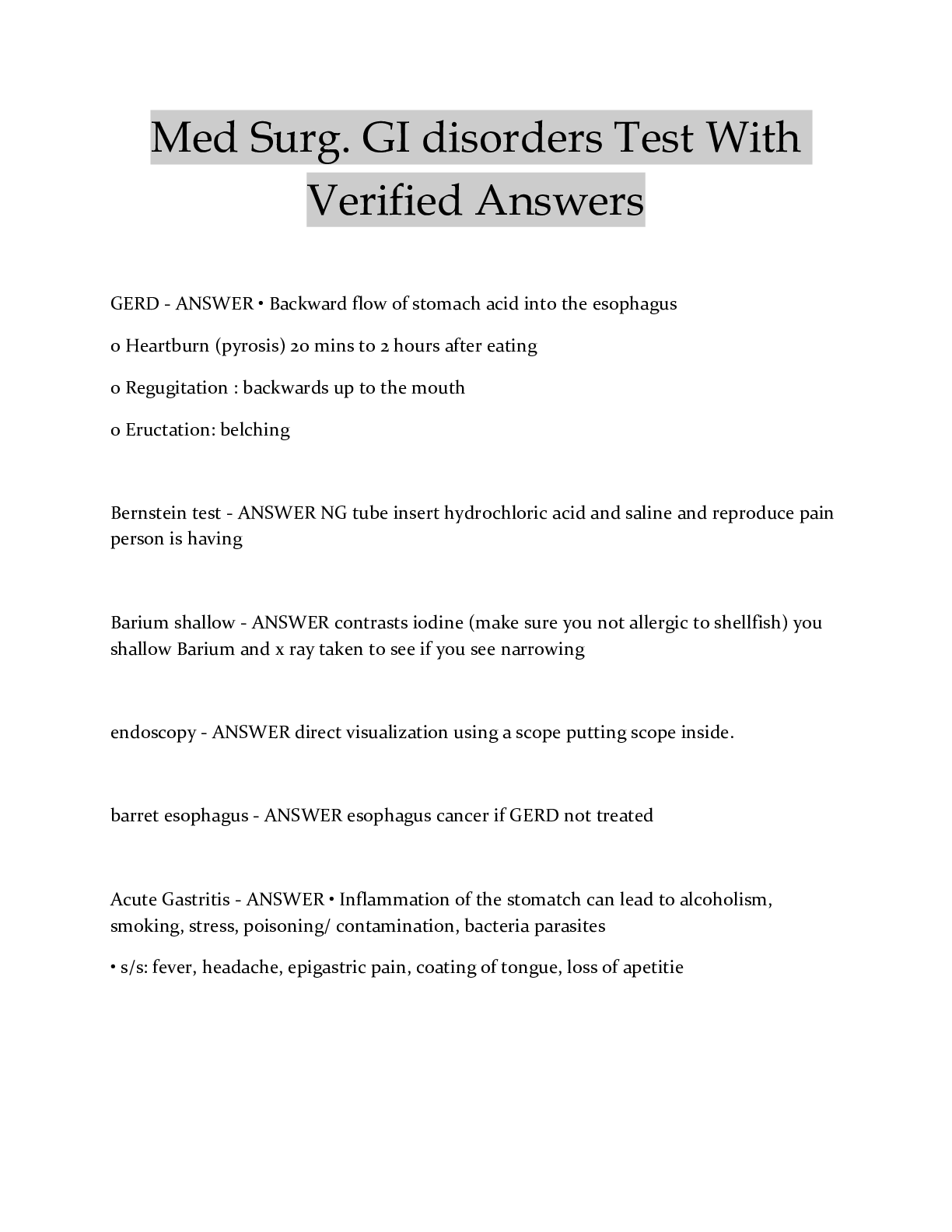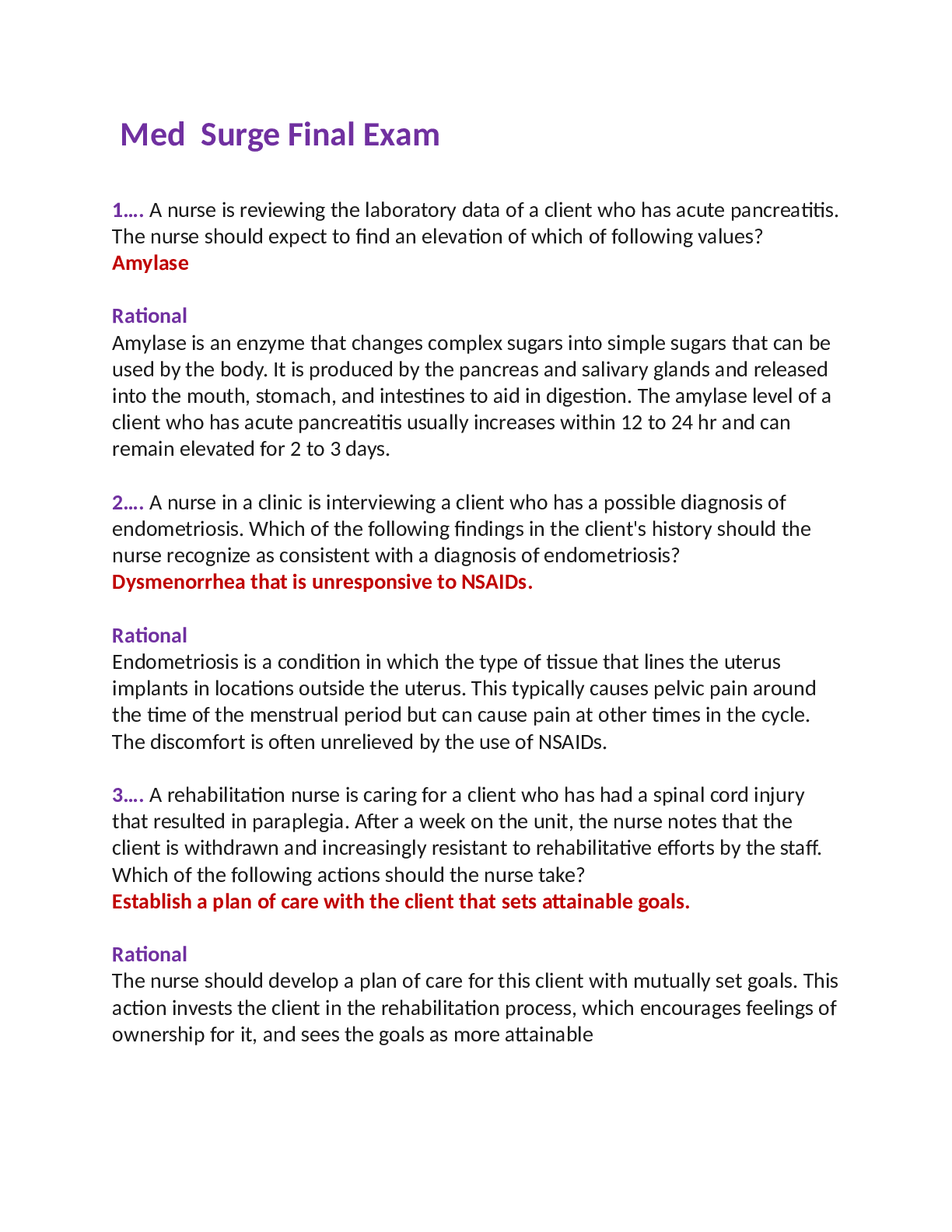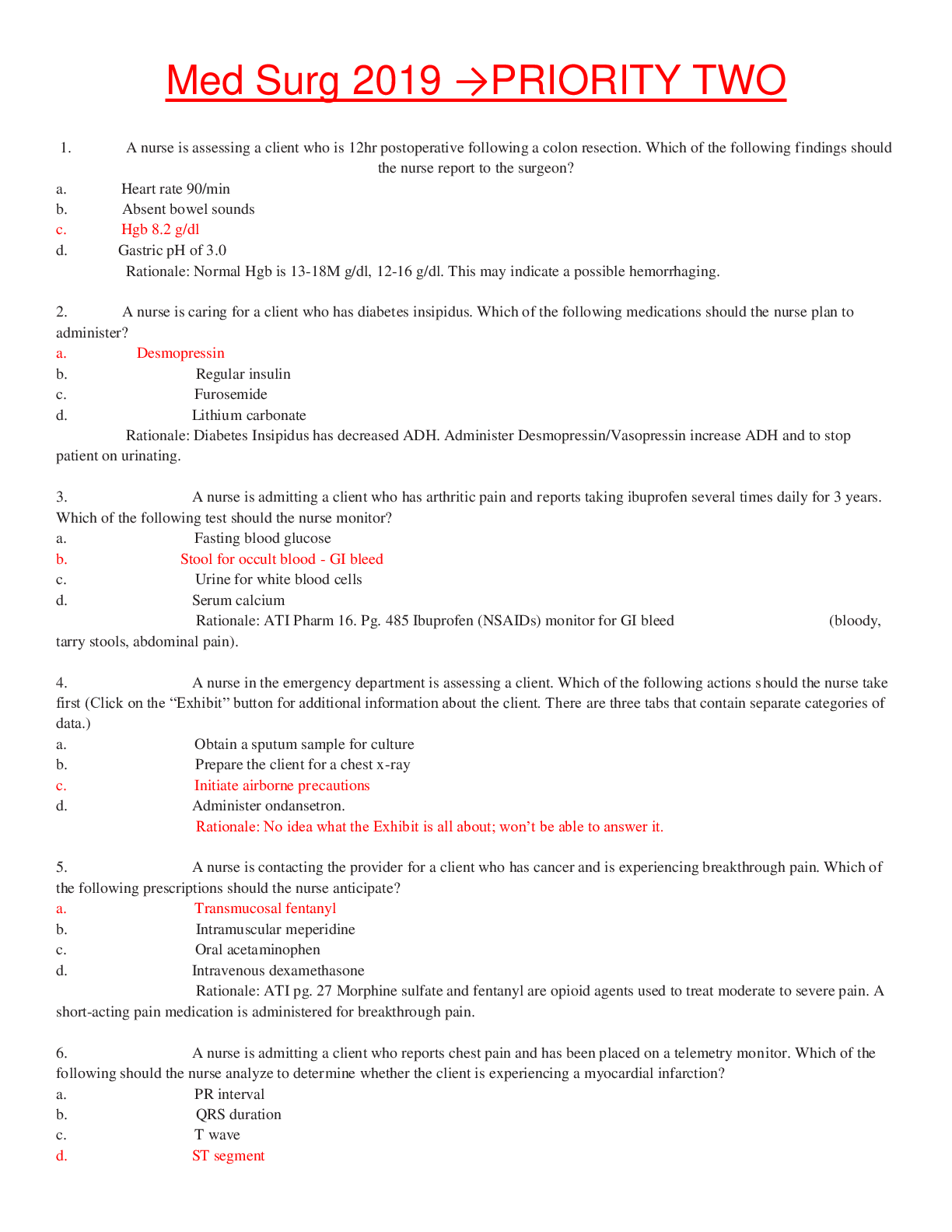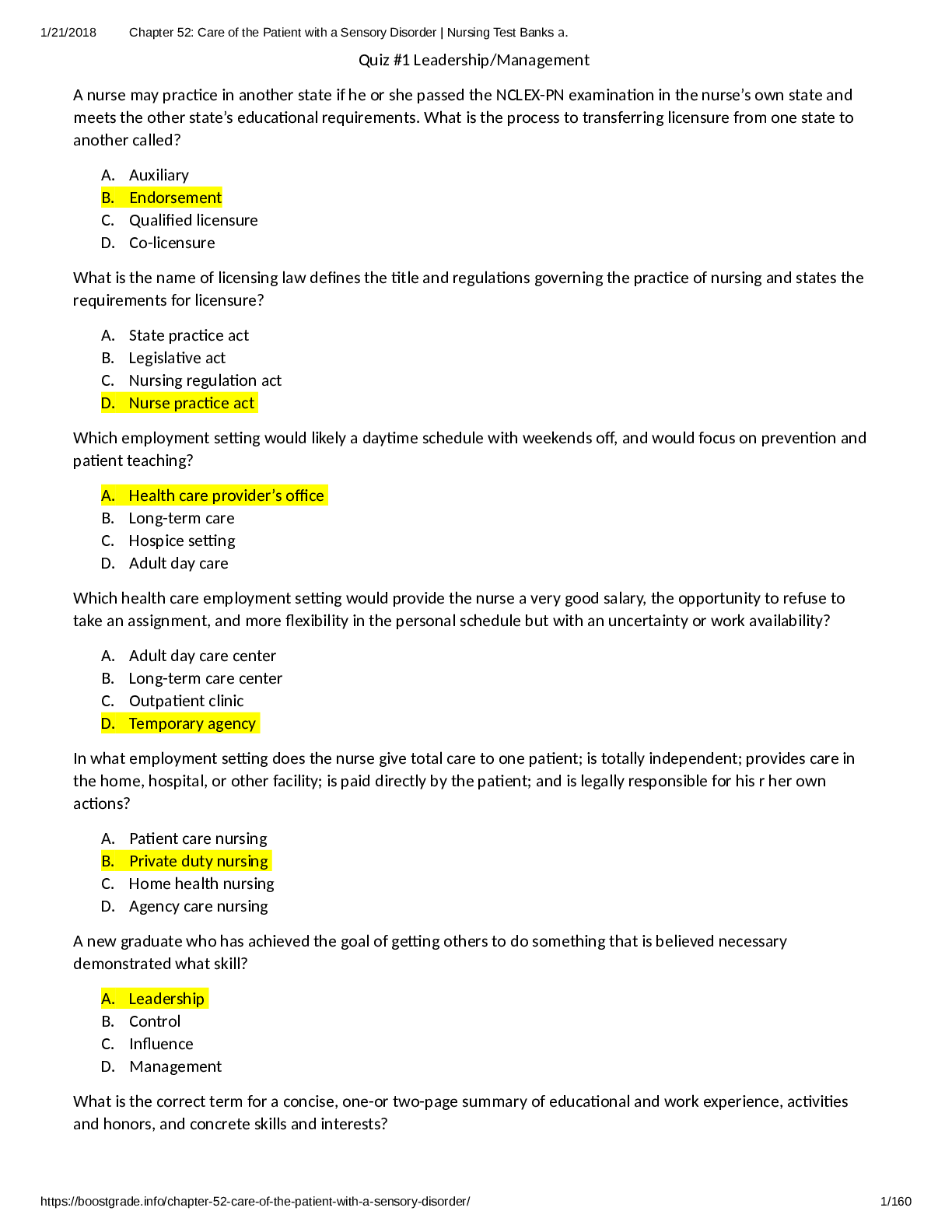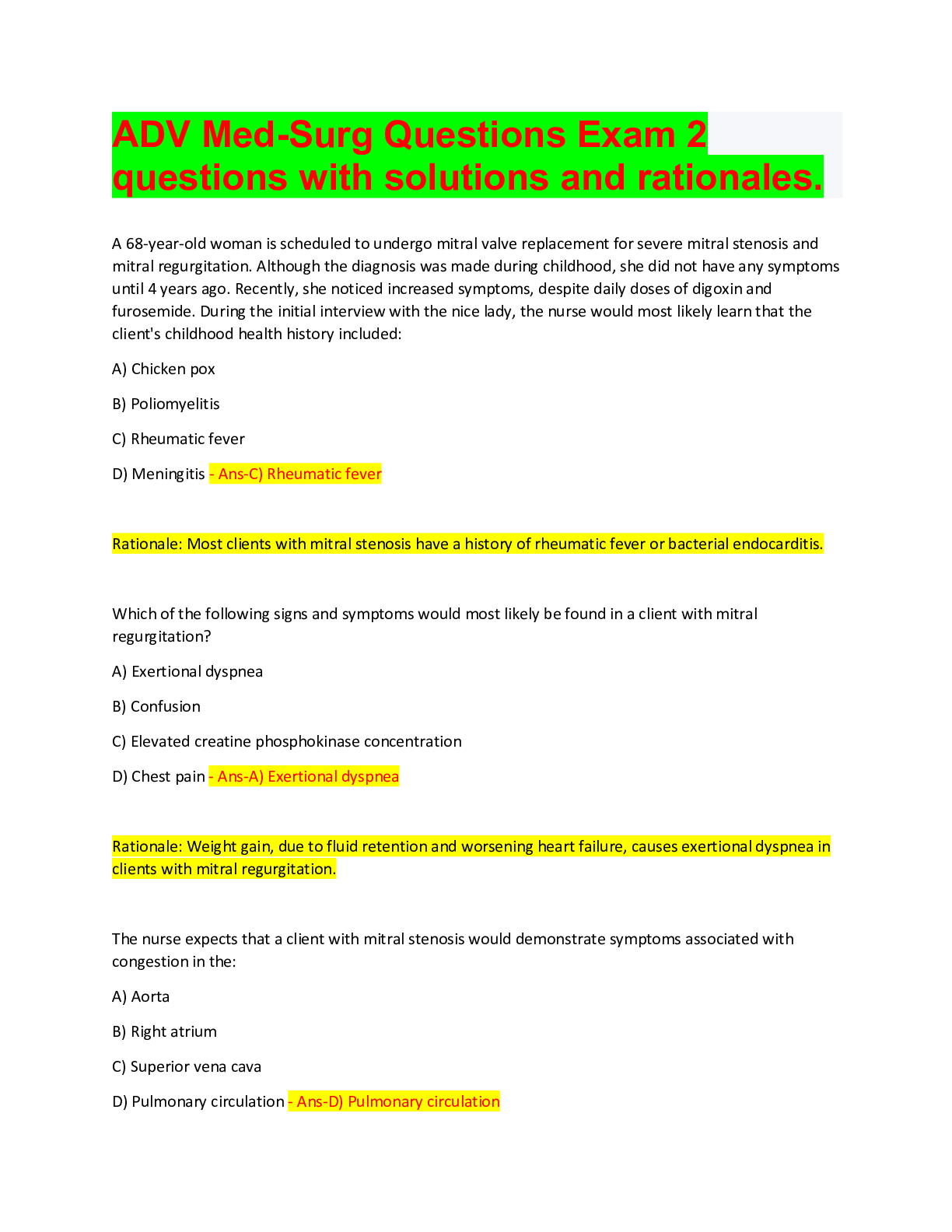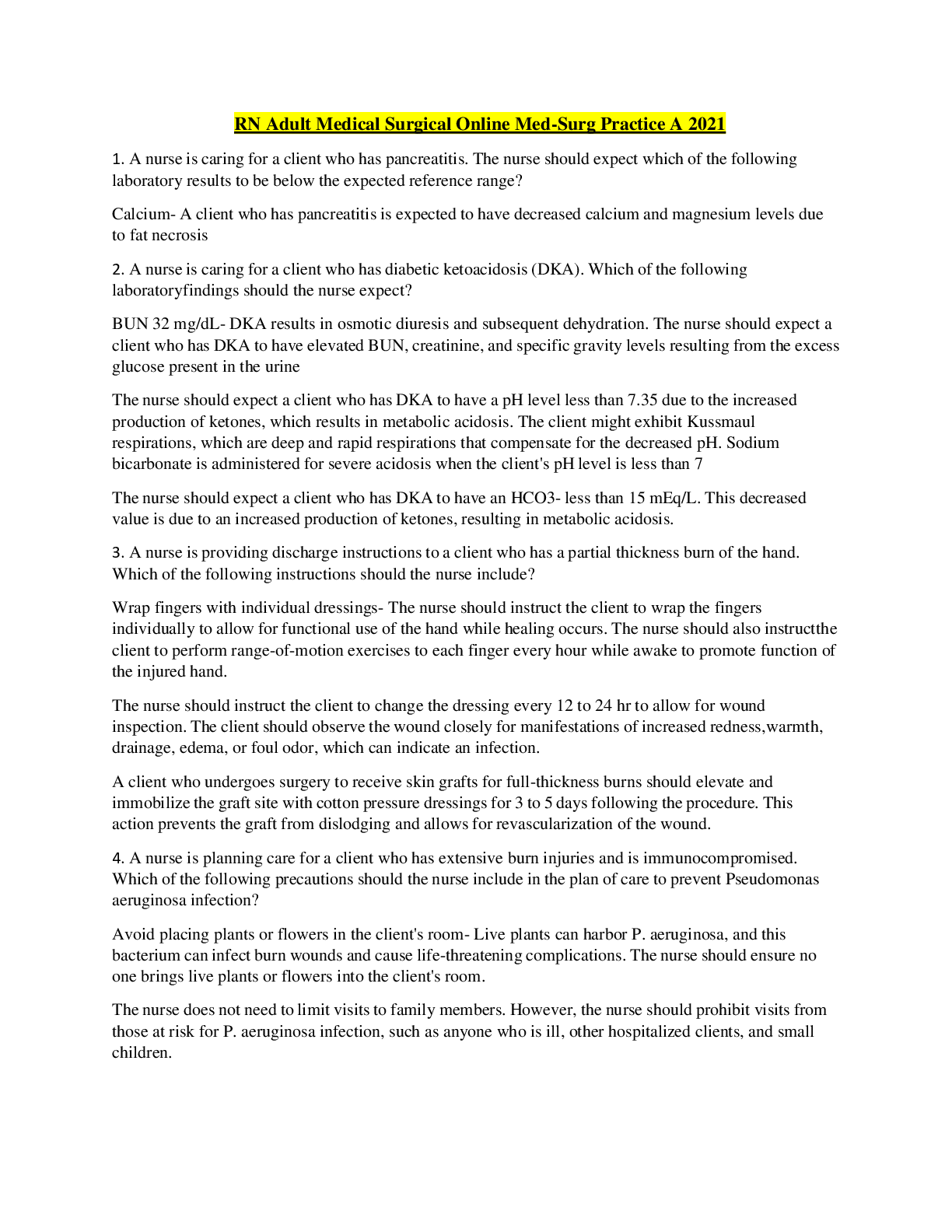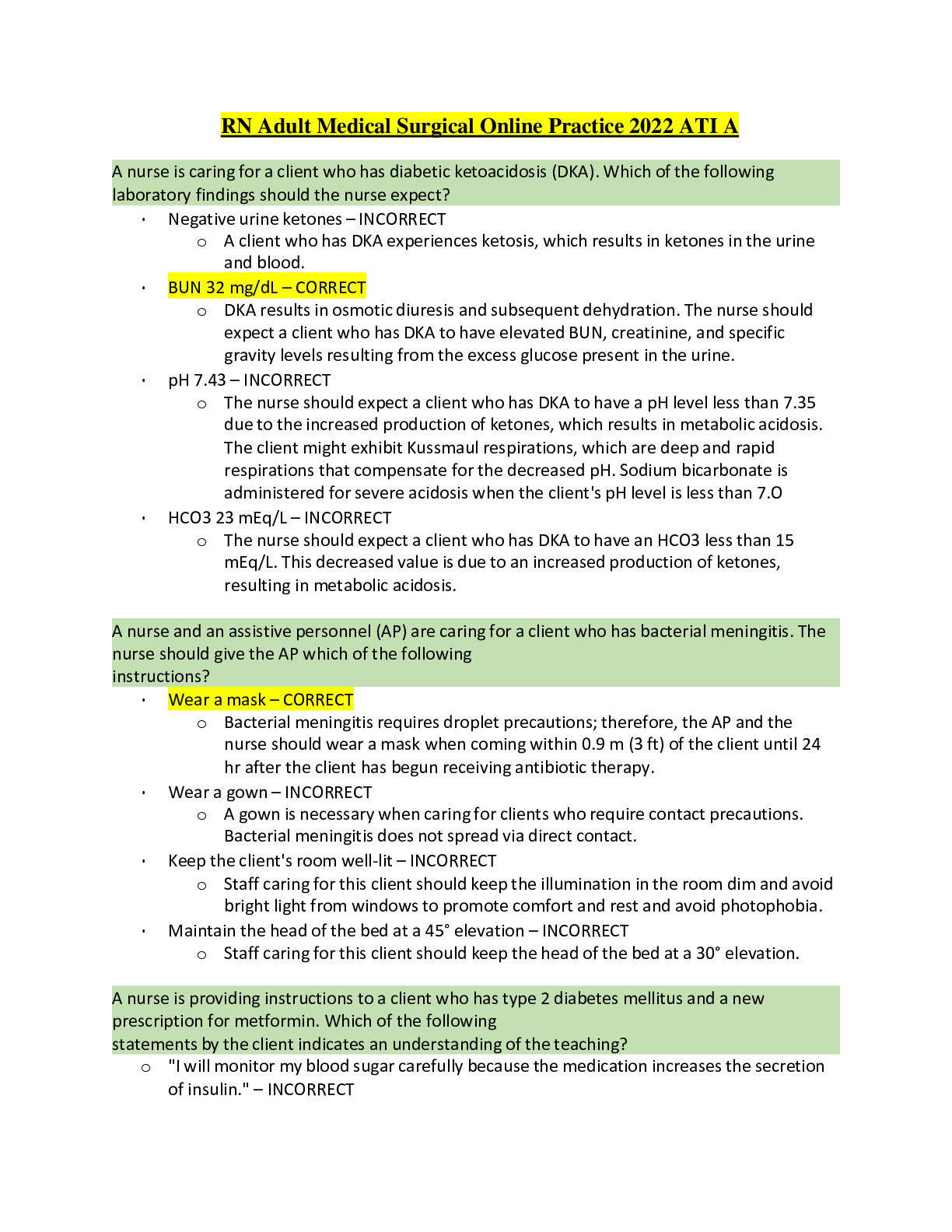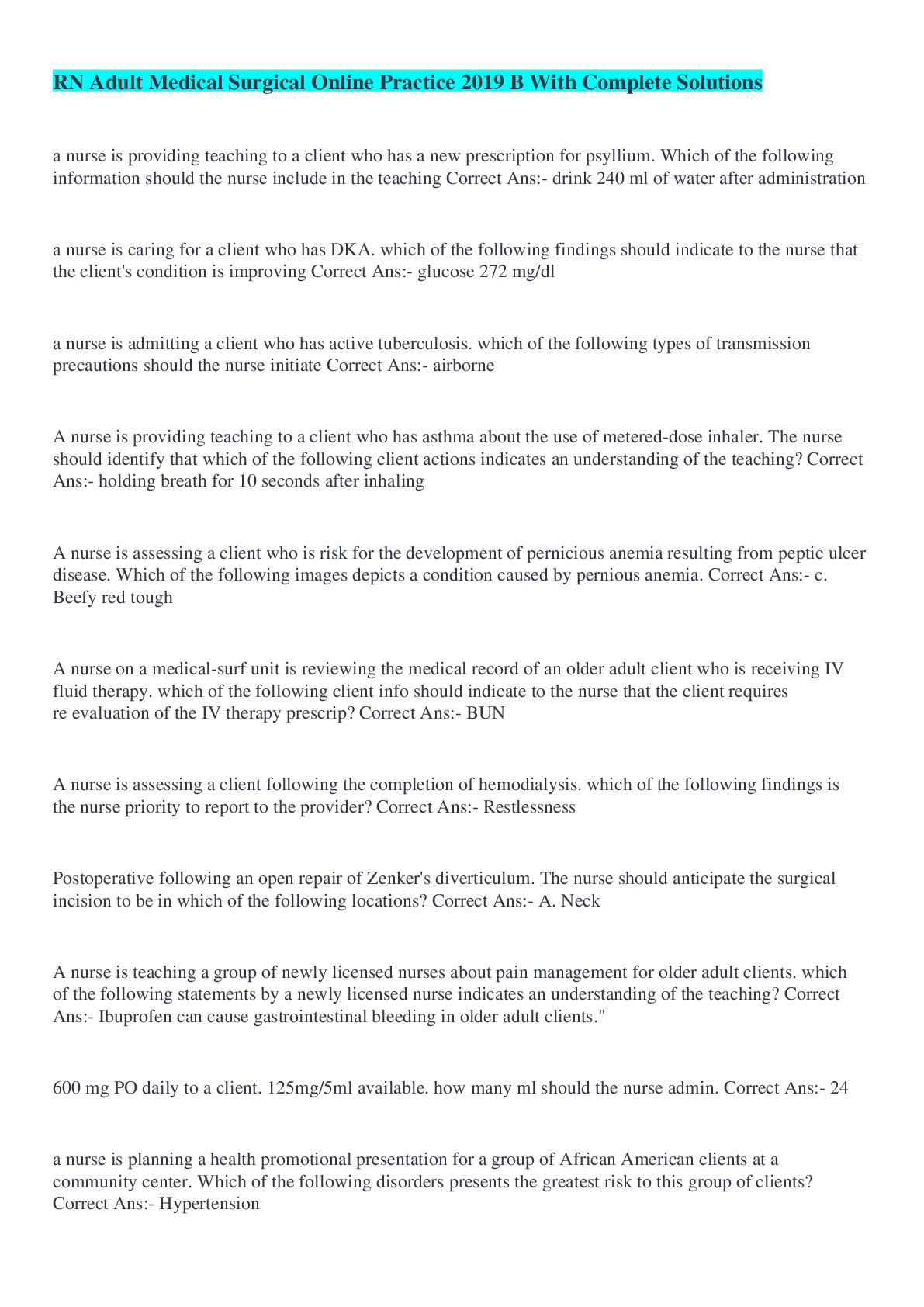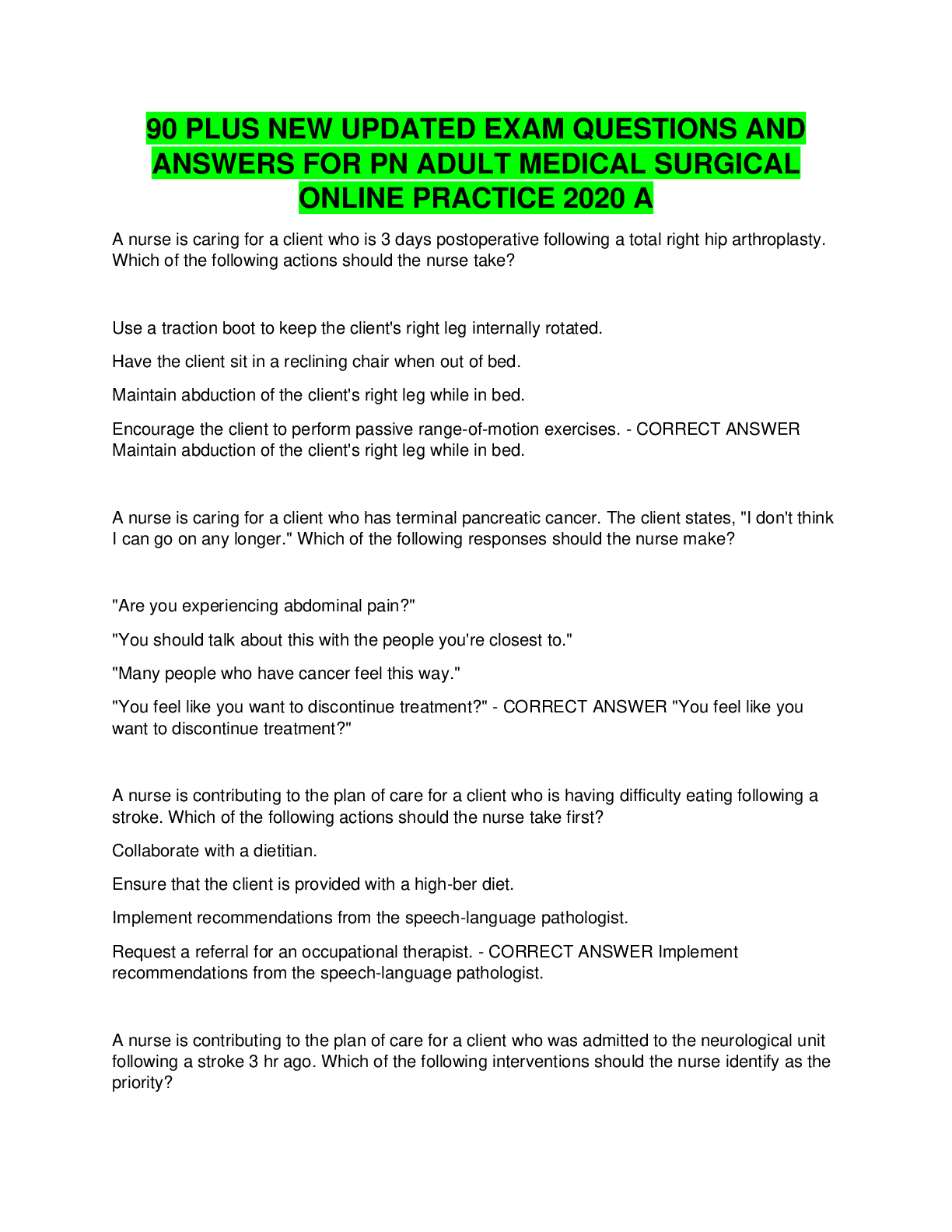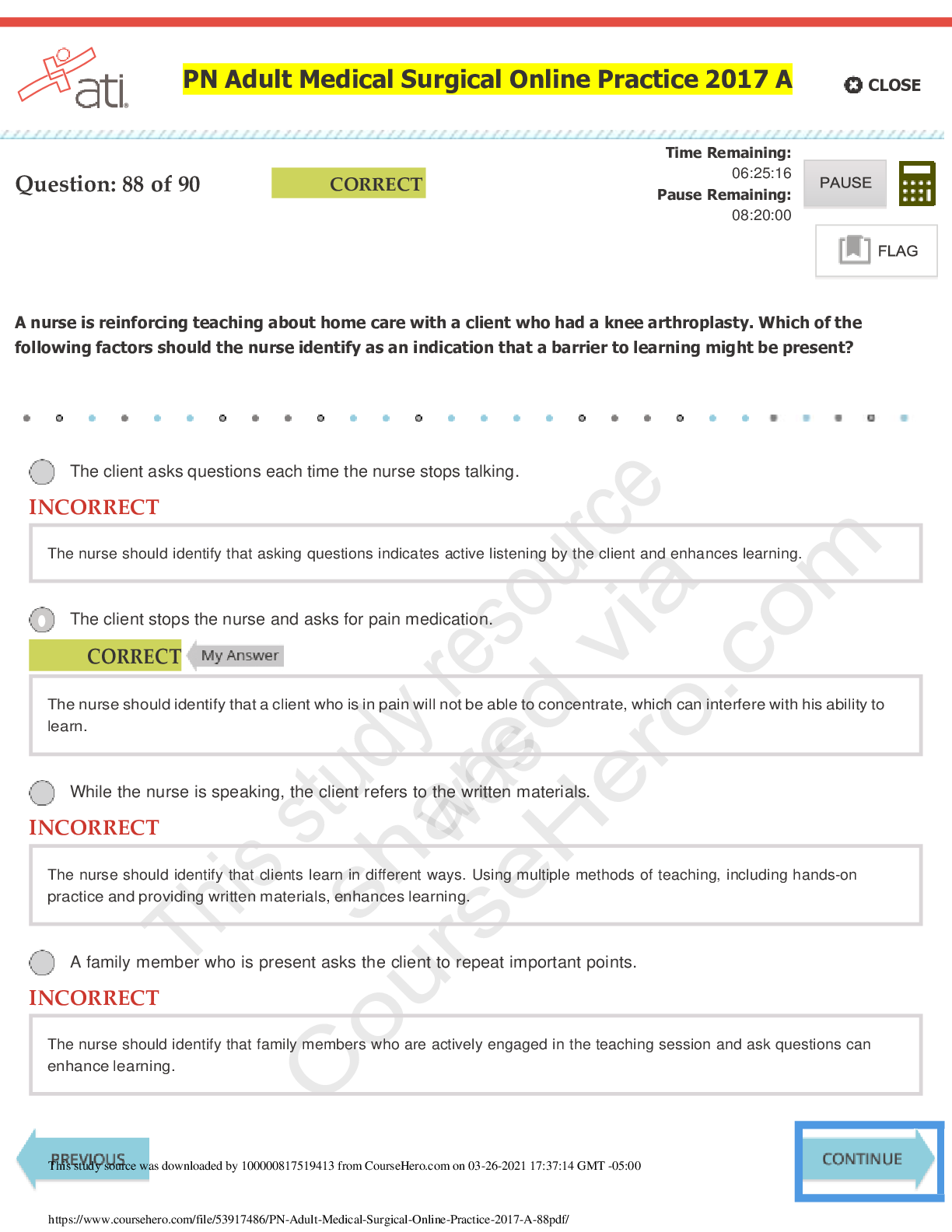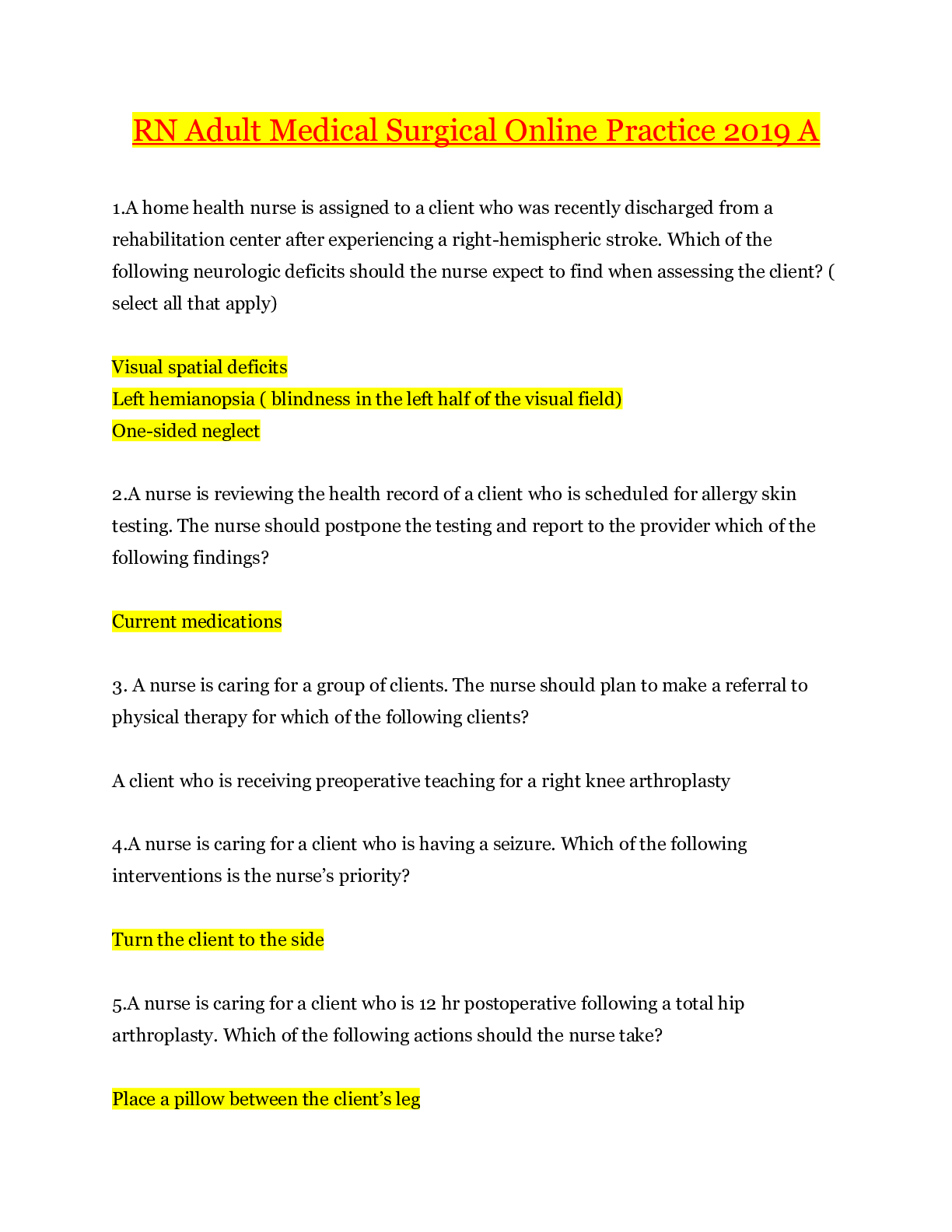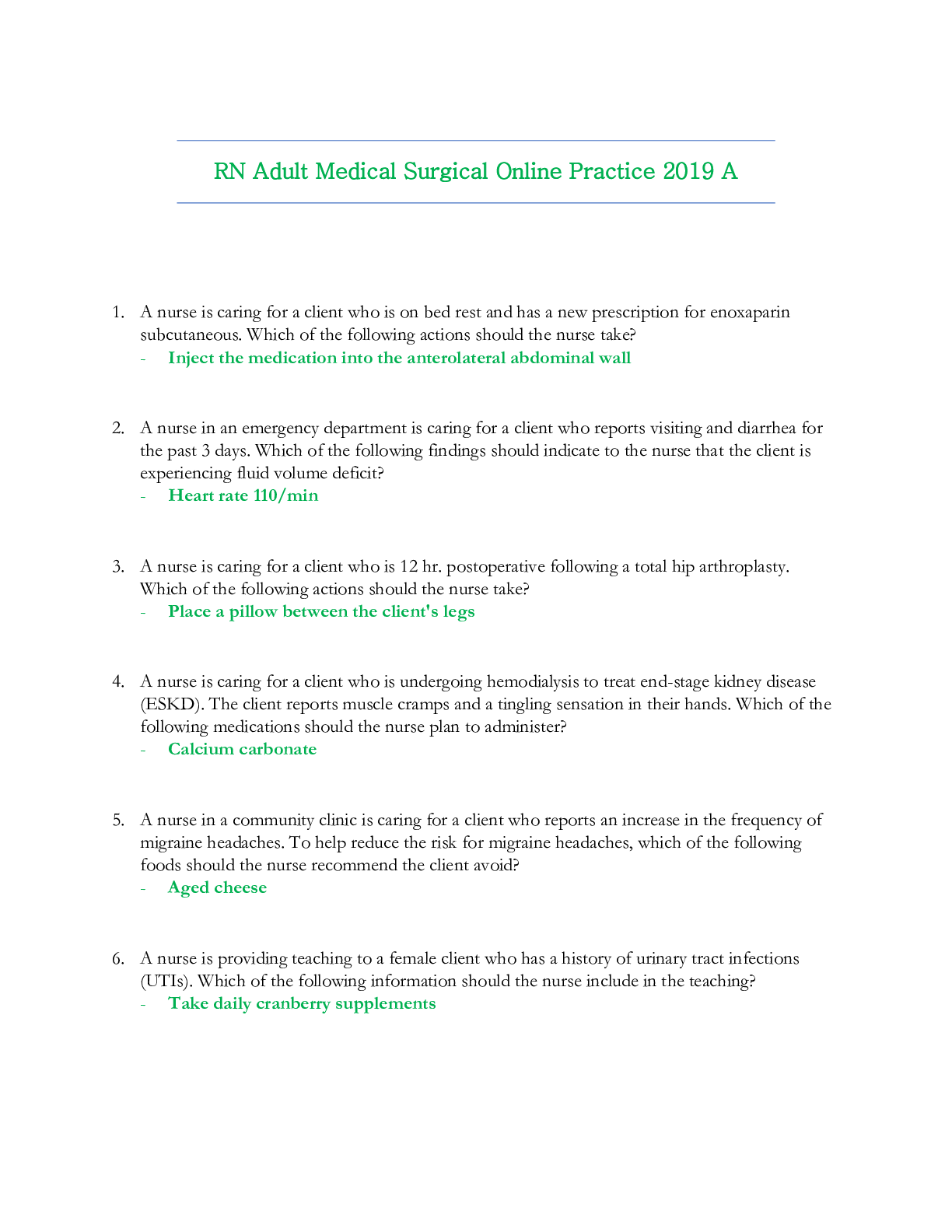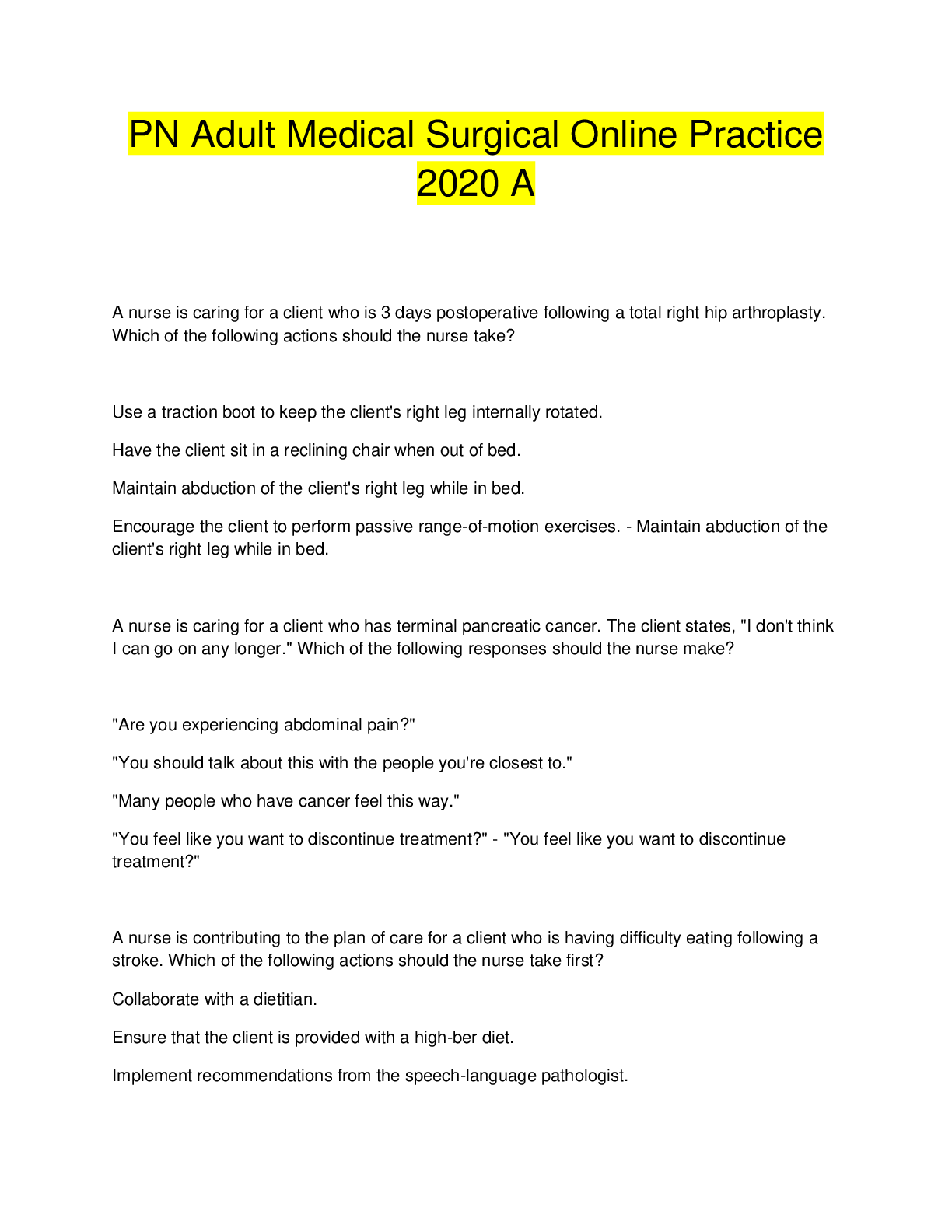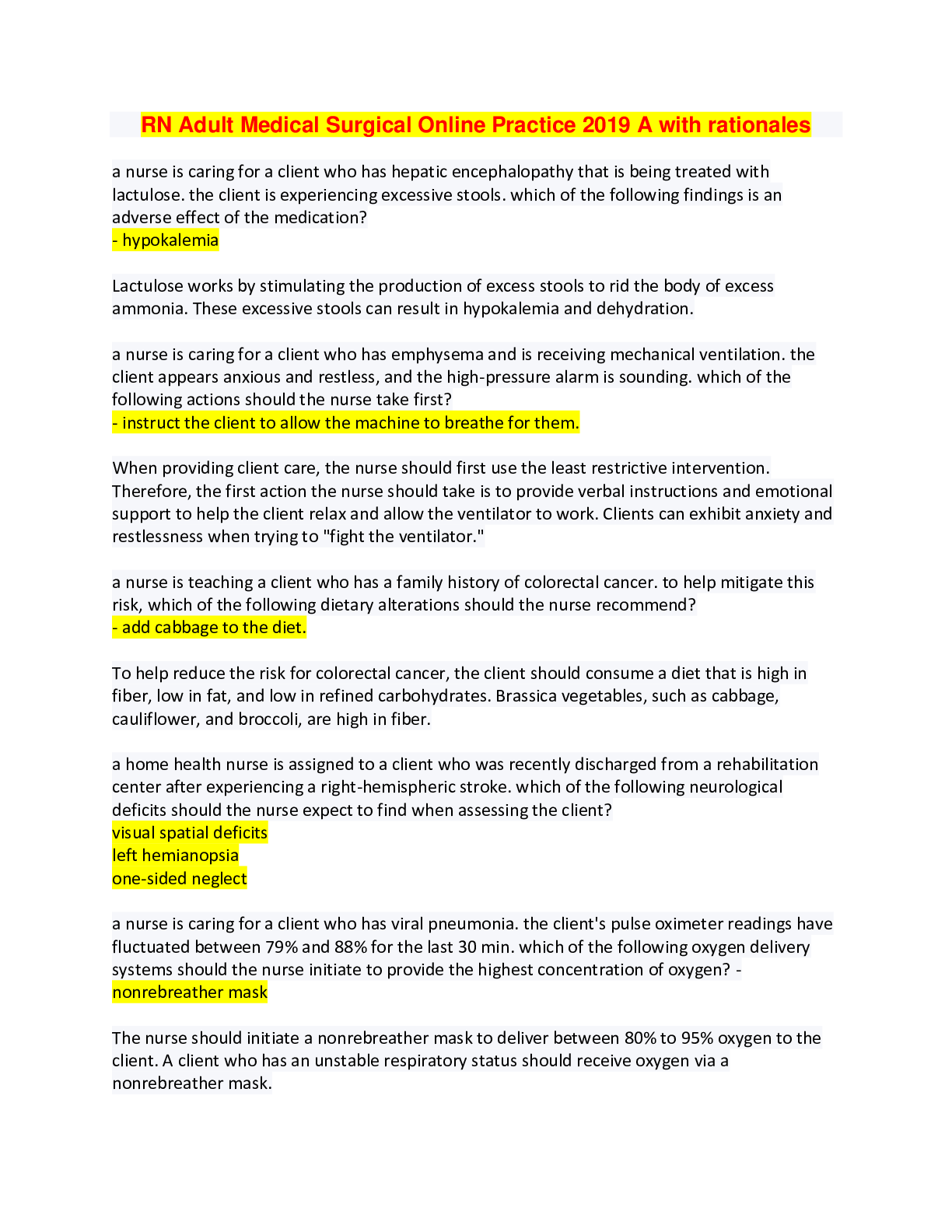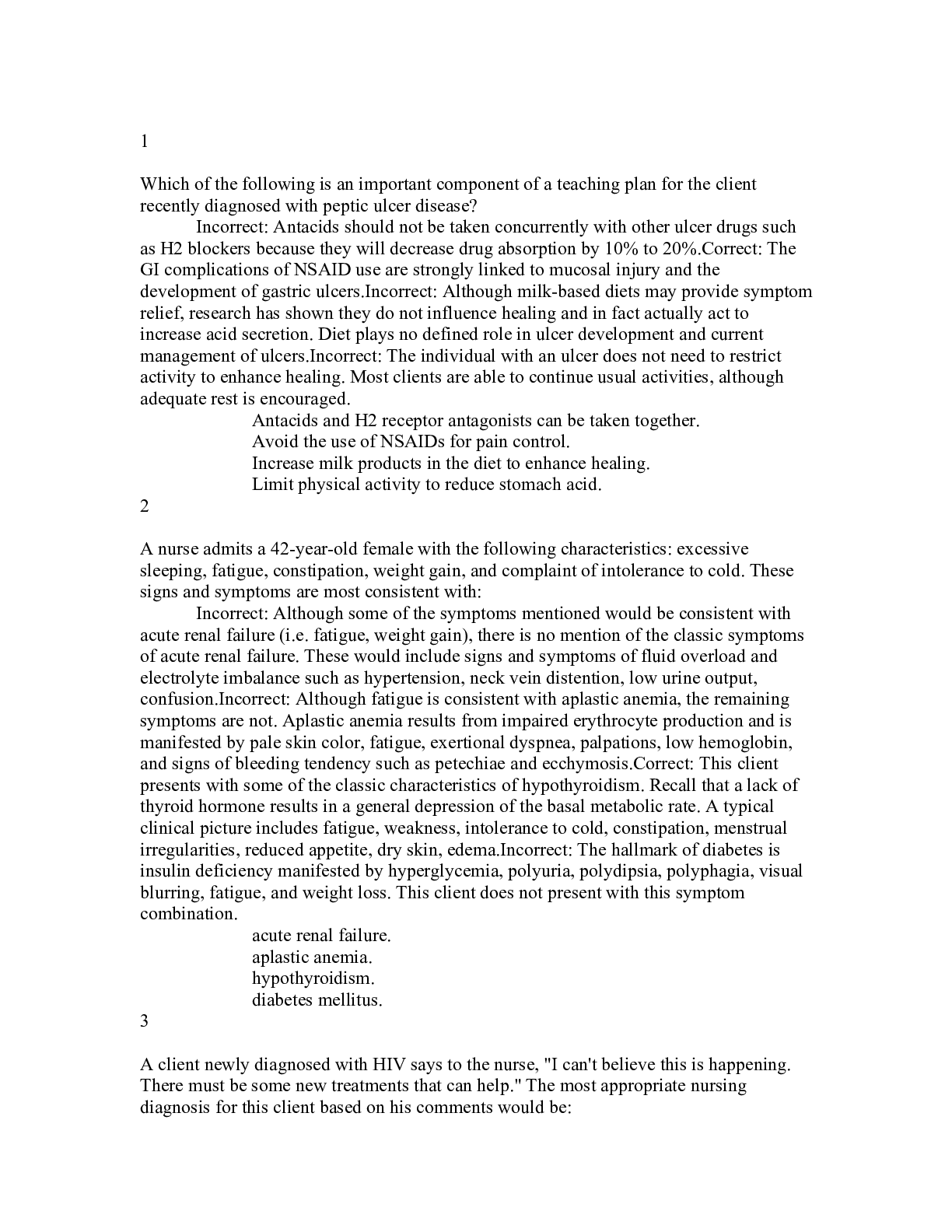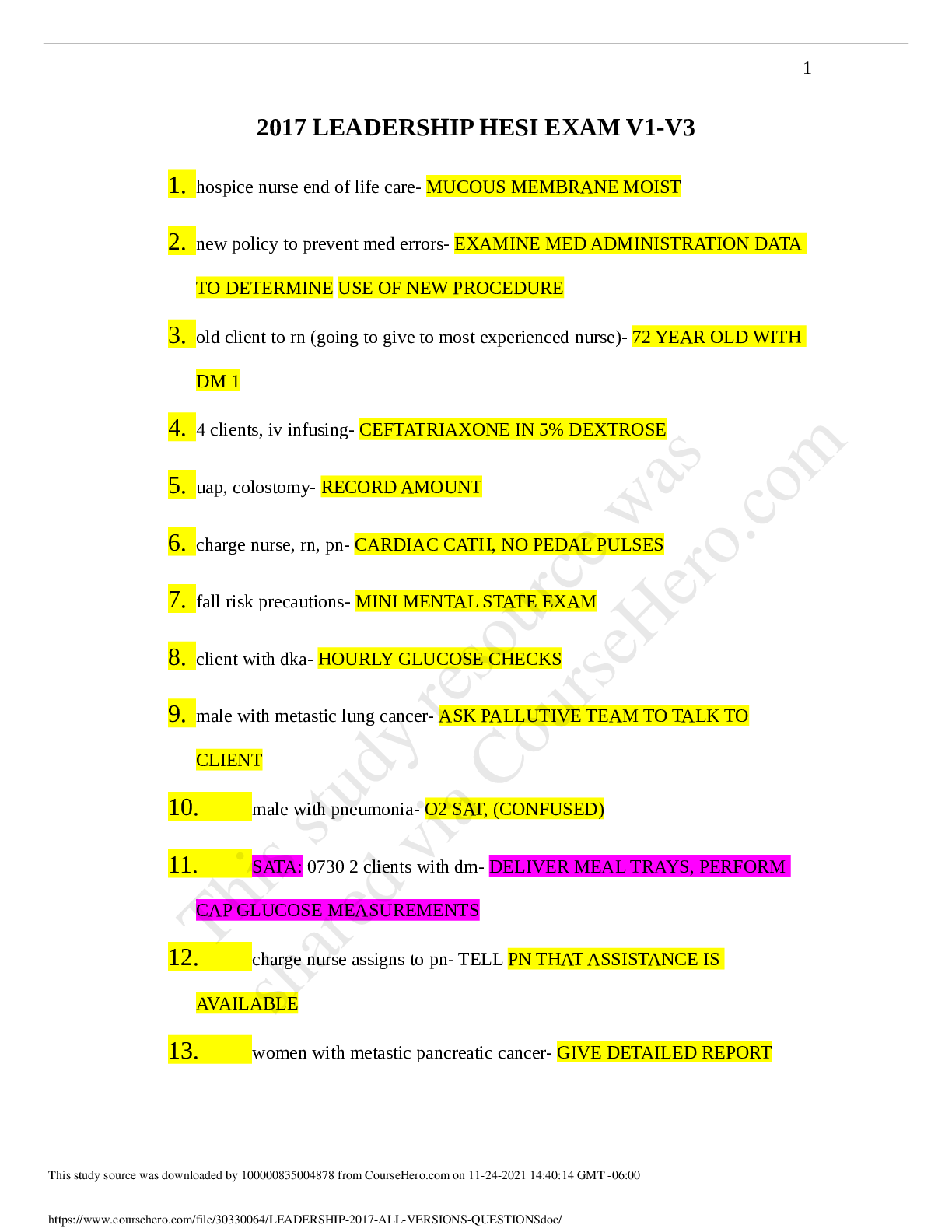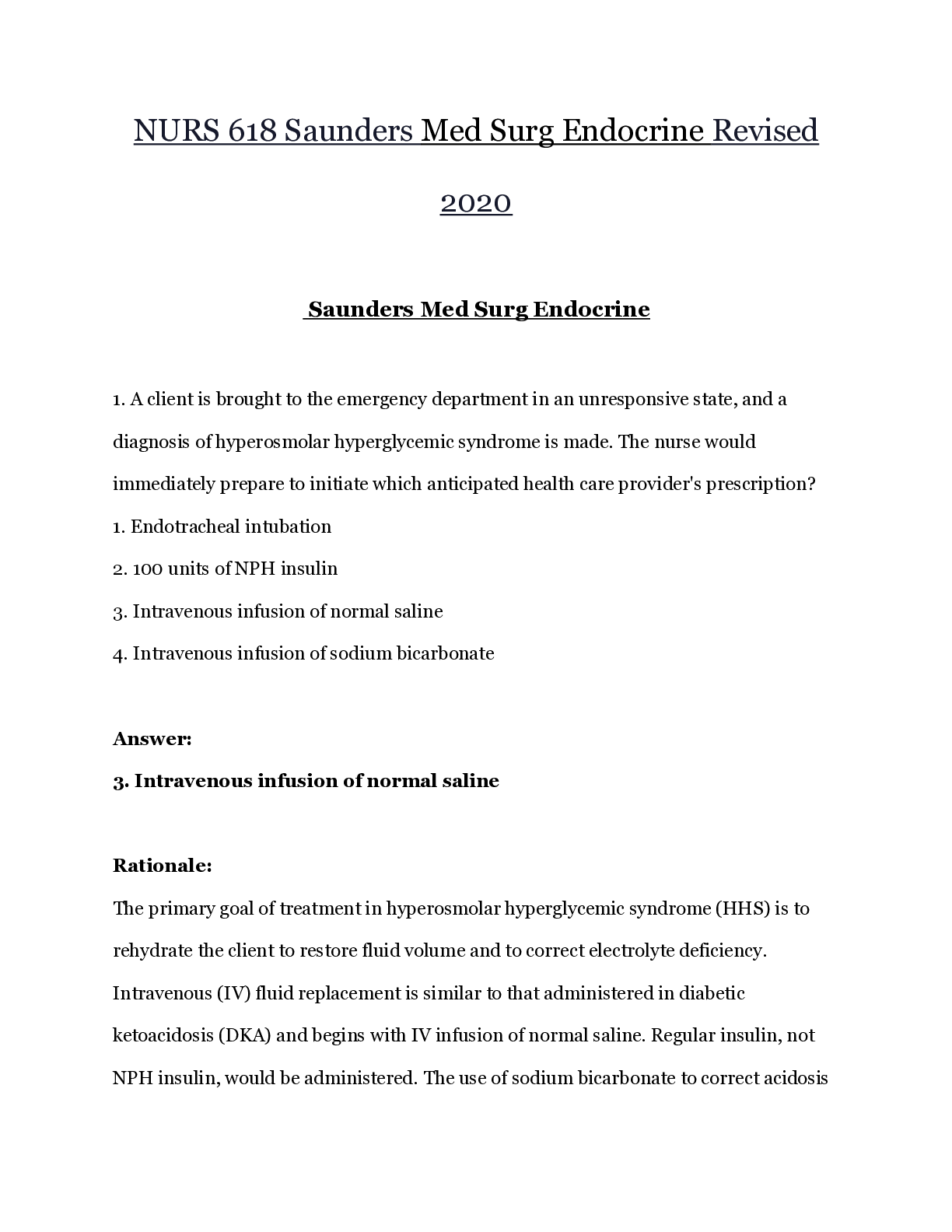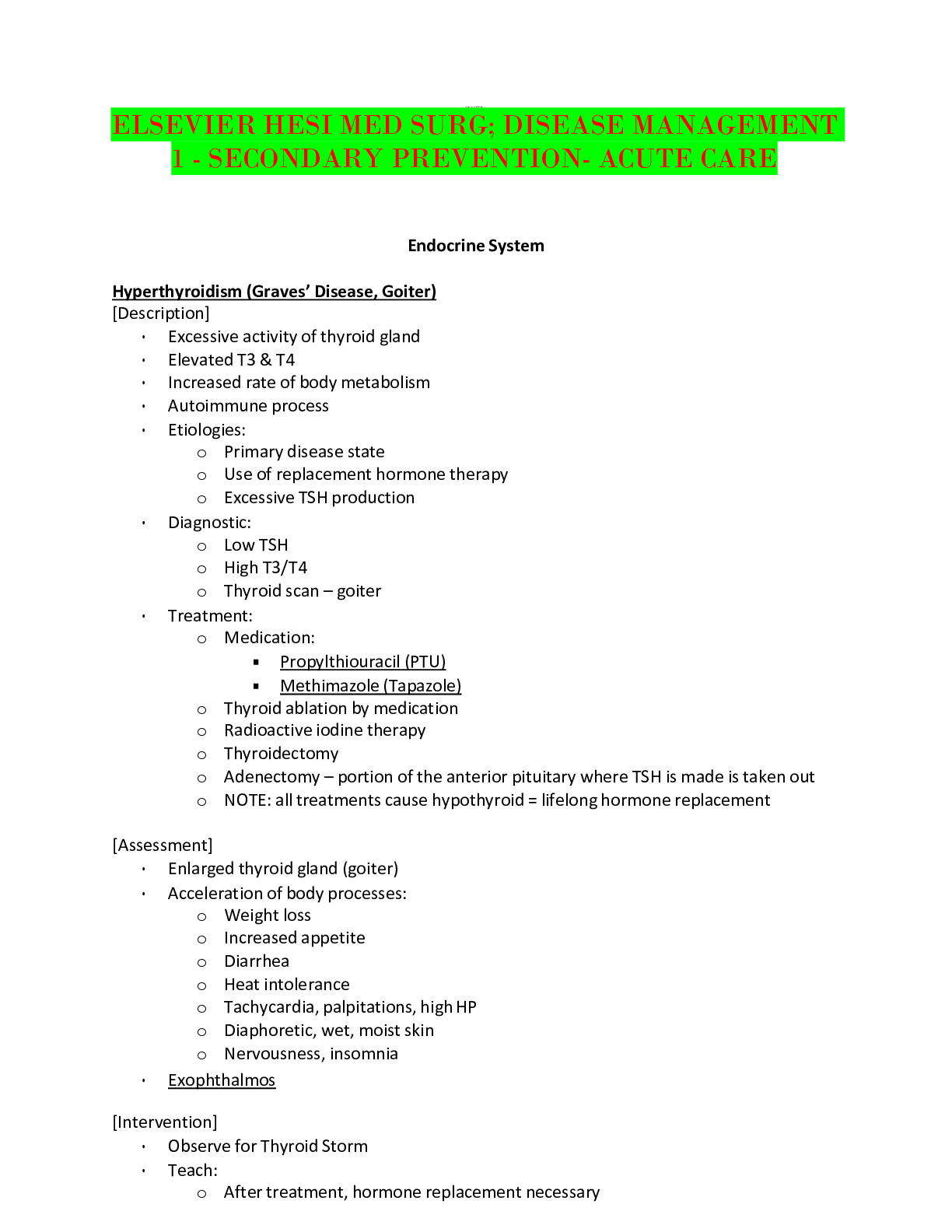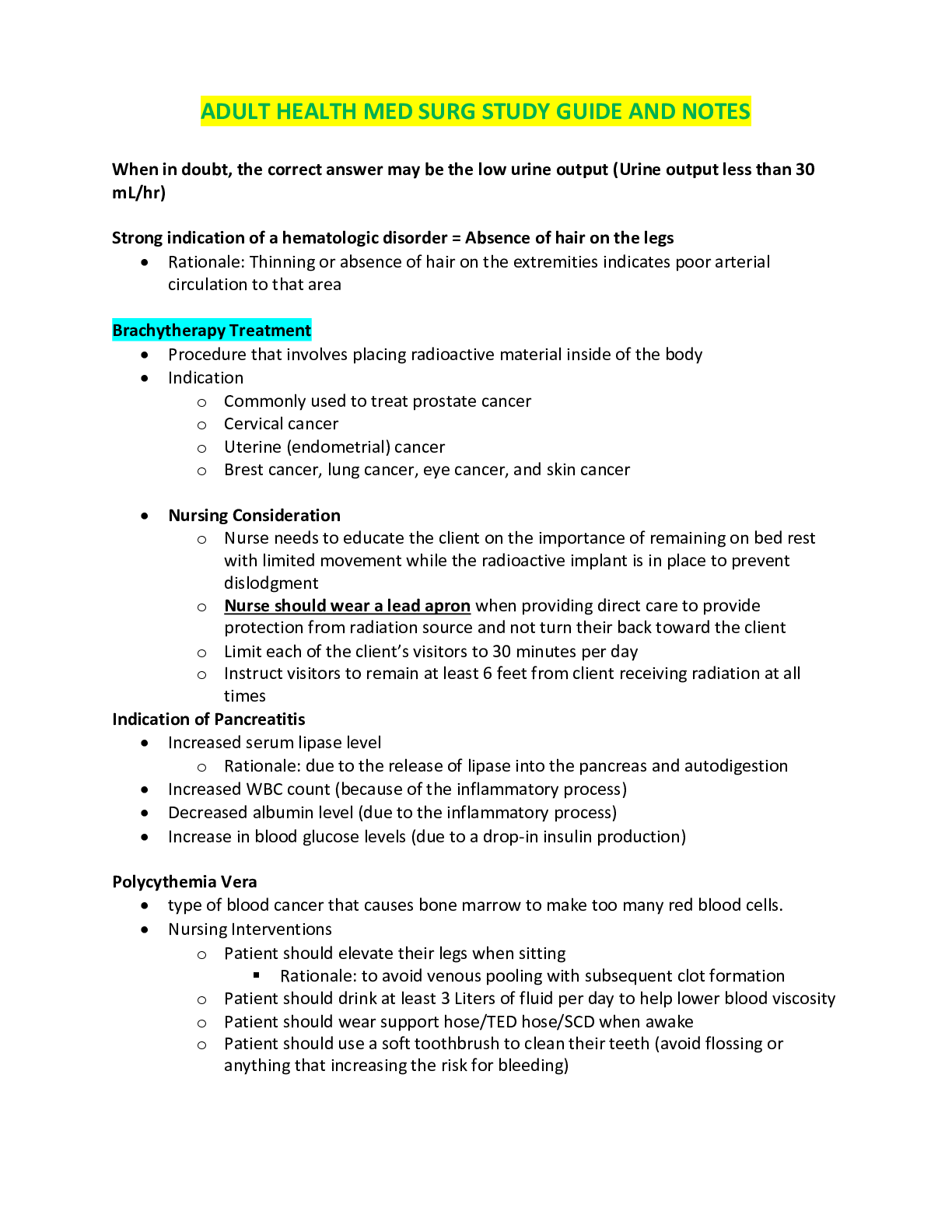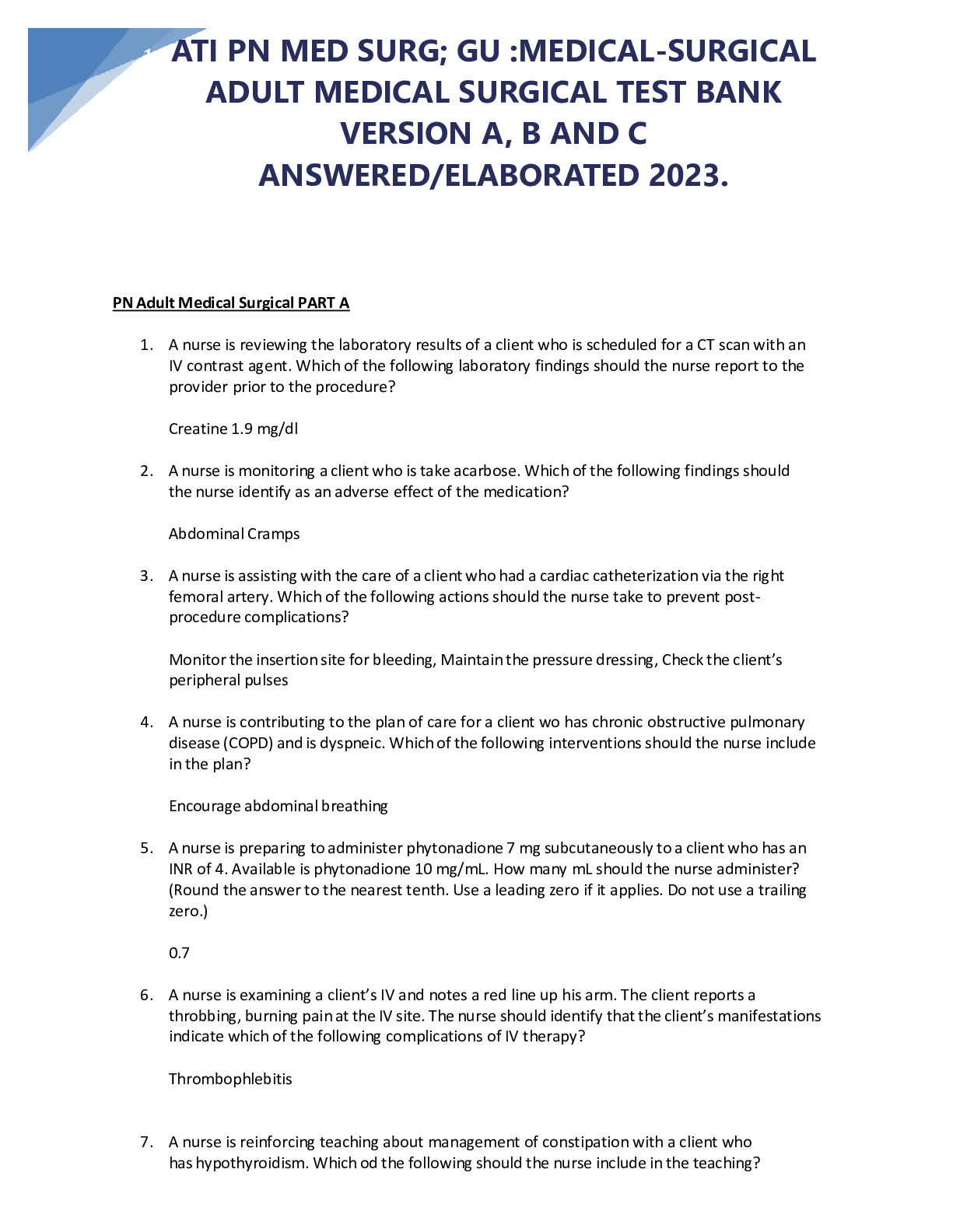*NURSING > MED-SURG EXAM > RN Adult Medical Surgical Online Practce 2019 B (All)
RN Adult Medical Surgical Online Practce 2019 B
Document Content and Description Below
RN Adult Medical Surgical Online Practce 2019 B 1) A nurse is providing teaching to a client who has a severe form of stage II Lyme disease. Which of the following statements made by the client re�... �ects an understanding of the teaching? a. “I will need to take antbiotcs for 1 year.” b. “My partner will need to take an antviral medicaton.” c. “My joints ache because I have Lyme Disease.” d. “I bruise easily because I have Lyme Disease.” 2) A Nurse is caring for a client who is 4 hr postoperatve following an open reducton internal fxaton of the right ankle. Which of the following assessment fndings should the nurse report to the provider? a. Extremity cool upon palpaton b. Serosanguineous drainage on the dressing. c. Capillary refll of 2 seconds. d. Client report of discomfort when moving toes. 3) A nurse is assessing a client while suctoning the client’s tracheostomy tube. Which of the following fndings should indicate to the nurse the client is experiencing hypoxia? a. The client starts to cough b. The client’s heart rate increases c. The client is diaphoretc d. The client’s blood pressure decreases 4) A nurse is caring for a client who is 8 hr postoperatve following a total hip arthroplasty. The client is unable to void on the bedpan. Which of the following actons should the nurse take frst? a. Document the client’s intake and output. b. Scan the bladder with a portable ultrasound. c. Pour warm water over the client’s perineum. d. Perform a straight catheterizaton. 5) A nurse is providing discharge instructons to a client who has actve tuberculosis (TB). Which of the following informaton should the nurse include in the instructons? a. Sputum specimens are necessary every 2 to 4 weeks untl there are three negatve cultures. b. The contagious period generally lasts for 6 to 8 weeks afer the initaton of medicaton therapy. c. Family members should follow airborne precautons at home. d. A follow-up tuberculosis 6) A nurse is caring for a client who has increased intracranial pressure (ICP) and is receiving mannitol via contnuous IV infusion. Which of the following fndings should the nurse report to the provider as an adverse effect of this medicaton? a. Decreased heart rate b. Crackles heard on auscultaton c. Increased urinary output d. Decreased deep tendon reflexes7) A nurse is providing discharge teaching to a client who is postoperatve following a modifed radical mastectomy. Which of the following instructons should the nurse include? a. Flex the affected arm when ambulatng b. Numbness can occur along the inside of the affected arm c. Begin actve range-of-moton exercises 1 day afer surgery d. Dress in clothing that fts snugly 8) A nurse is providing educaton to a client who has tuberculosis (TB) and their family. Which of the following informaton should the nurse include in the teaching? a. Afer 1 week of medicaton, TB is no longer communicable. b. Dispose of contaminated tssues in a paper bag. c. Airborne precautons are necessary in the home. d. Family members in the household should undergo TB testng. 9) A nurse is providing discharge teaching about infecton preventon to a client who has AIDS. Which of the following statements by the client indicates understanding of the teaching? a. “I will eat a salad at least once each day to increase my intake of vitamin K.” b. “I can work in my flower garden as long as I wear gardening gloves to cover my skin.” c. “I will no longer floss my teeth afer brushing my teeth.” d. “I can sip on a glass of juice for at least 2 hours before I should discard it.” 10) A nurse is assessing a client who is at risk for the development of pernicious anemia resultng from peptc ulcer disease. Which of the following images depicts a conditon caused by pernicious anemia? a.11) A nurse is reviewing the laboratory results of a client who has aplastc anemia. Which of the following fndings indicates a potental complicaton? a. RBC count 5.2 million/mm3 b. WBC count 2,000/mm3 c. Platelets 380,000/mm3 d. Potassium 4 mEq/L 12) A nurse is assessing heart sounds of a client who reports substernal precordial pain. Identfy which of the following sounds the nurse should document in the client’s medical record by listening to the audio clip. a. Murmur b. S4 c. Pericardial fricton rub d. Ventricular gallop 13) A nurse is admitng a client who has actve tuberculosis. Which of the following types of transmission precautons should the nurse initate? a. Airborne b. Droplet c. Contact d. Protectve environment 14) A nurse is preparing to present a program about preventon of atherosclerosis at a health fair. Which of the following recommendatons should the nurse plant to include? (select all that apply) a. Follow a smoking cessaton program b. Maintain an appropriate weight c. Eat a low-fat diet d. Increase fluid intake e. Decrease intake of complex carbohydrates 15) A home health nurse is providing teaching to a client who has a stage 1 pressure injury on the greater trochanter of his lef hip. Which of the following instructons should the nurse include in the teaching? a. Clean the wound daily with an antseptc b. Use a donut-shaped pillow when sitng in a chair c. Change positon every hour d. Massage the area two tmes daily 16) A nurse is providing teaching to a client who takes ginkgo biloba as an herbal supplement. Which of the following statements should the nurse make? a. “Ginkgo biloba relieves nausea for people who have vertgo.” b. “Taking ginkgo biloba will help relieve your joint pain.” c. “Ginkgo biloba can cause an increased risk for bleeding.” d. “Taking ginkgo biloba decreases the risk of migraine headache.” 17) A nurse is providing teaching to a client who has a new prescripton for psyllium. Which of the following informaton should the nurse include in the teaching? a. Drink 240 mL (8 oz) of water afer administraton. b. Expect results in 4 to 6 hrc. Take this medicaton before meals to increase appette. d. Reduce dietary fber intake to improve medicaton absorpton. 18) A nurse is assessing a client who has advanced lung cancer and is receiving palliatve care. The client has just undergone thoracentesis. The nurse should expect a reducton in which of the following common manifestatons of advanced cancer? a. Dyspnea b. Hemoptysis c. Mucus producton d. Dysphagia 19) A nurse is caring for a client who is receiving mechanical ventlaton via a tracheostomy tube. The nurse should recognize that which of the following complicatons is associated with long-term mechanical ventlaton? a. Elevated blood pressure b. Dehydraton c. Stress ulcers d. Hypernatremia 20) A nurse is assessing a client who is postoperatve following a thyroidectomy. Which of the following fndings is the nurse’s priority? a. Moderate serosanguinous drainage on the dressing b. Calcium 9.5 mg/dL c. Temperature 38.9C (102F) d. Decreased bowel sounds 21) A nurse is teaching a family about the care of a parent who has a new diagnosis of Alzheimer’s disease. Which of the following informaton should the nurse include in the teaching? a. Positon tabletop clocks with mult-colored backgrounds throughout the home. b. Explain how to complete a task while having the client do the task. c. Place a calendar on the wall with days and weeks included. d. Create complete outits and allow the client to select one each day. 22) A nurse on a medical-surgical unit is reviewing the medical record of an older adult client who is receiving IV fluid therapy. Which of the following client informaton should indicate to the nurse that the client requires re-evaluaton of the IV therapy prescripton? a. Blood pressure (118/68) b. Prescribed medicatons (propranolol, metormin, alendronate sodium) c. Oxygen saturaton (96%) d. BUN (29 mg/dL) 23) A nurse is providing preoperatve teaching for a client who is scheduled for a mastectomy. Which of the following statements should the nurse make? a. “You should accept your body image change before discharge.” b. “It is important for you to look at the incisional site when the dressings are removed.” c. “I will refer you to community resources that can provide support.” d. “The scar will remain red and raised for many years afer surgery.”24) A nurse is caring for a client following extubatng of an endotracheal tube 10 min ago. Which of the following fndings should the nurse report to the provider immediately? a. Stridor b. Oral secretons c. Hoarseness d. Sore throat 25) A nurse is assessing a client who has diabetes insipidus. Which of the following fndings should the nurse expect? a. Low urine specifc gravity b. Hypertension c. Bounding peripheral pulses d. Hyperglycemia 26) A nurse is assessing a client who is postoperatve following a transurethral resecton of the prostate (TURP) and notes clots in the client’s indwelling urinary catheter and a decrease in urinary output. Which of the following actons should the nurse take? a. Remove the client’s indwelling urinary catheter b. Irrigate the indwelling urinary catheter c. Clamp the indwelling urinary catheter d. Apply tracton to the indwelling urinary catheter 27) A nurse is caring for a client who has an arterial line. Which of the following actons should the nurse take? a. Flush the line before administering antbiotcs b. Positon the client in Trendelenburg to obtain measurements c. Have the client bear down when readings are obtained d. Place a pressure bag around the flush soluton 28) A nurse is planning a health promotonal presentaton for a group of African American clients at a community center. Which of the following disorders presents the greatest risk to this group of clients? a. Multple sclerosis b. Skin cancer c. Urolithiasis d. Hypertension 29) A nurse is caring for an older adult client who has dementa and requires acute care for a respiratory infecton. The client is agitated and is atemptng to remove their IV catheter. Which of the following actons should nurse take to avoid restraining the client? a. Check on the client every 2 hr b. Provide a quiet environment with no distractons c. Turn on the television in the client’s room d. Keep the client occupied with a manual actvity 30) A nurse is planning discharge teaching for a client who has an external fxaton device for a fracture of the lower extremity. Which of the following instructons should the nurse include in the plan of care? a. Secure the straps frmly around the boot b. Remove the device before showeringc. Use crutches with rubber tps d. Adjust the screws to maintain alignment 31) A nurse is assessing a client who has peripheral arterial disease. Which of the following fndings should the nurse expect? a. Painless ulceratons on the ankles b. Hair loss on the lower legs c. No extremity pain when restng d. Rubor with elevaton of the extremity [Show More]
Last updated: 1 year ago
Preview 1 out of 16 pages
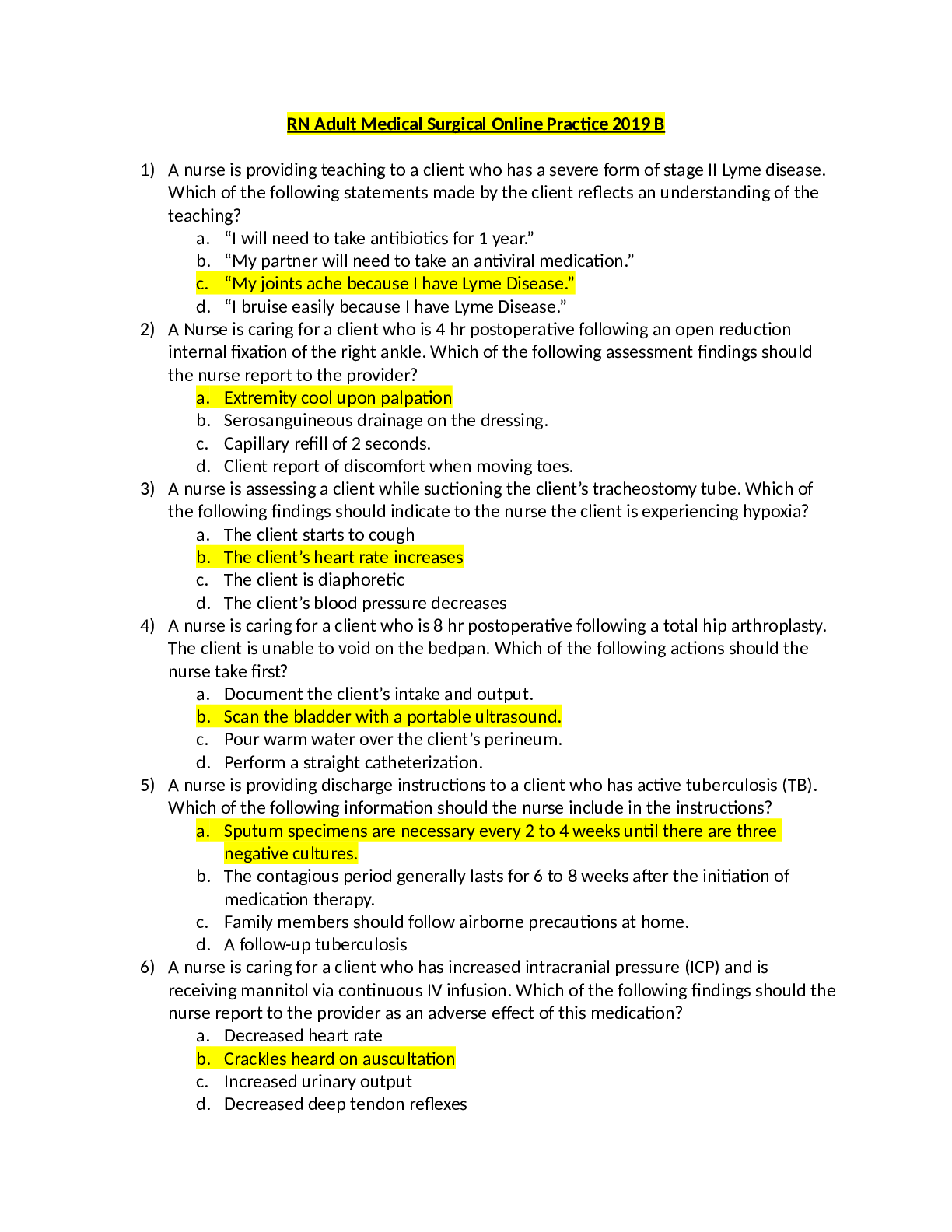
Reviews( 0 )
Document information
Connected school, study & course
About the document
Uploaded On
May 19, 2022
Number of pages
16
Written in
Additional information
This document has been written for:
Uploaded
May 19, 2022
Downloads
0
Views
390



